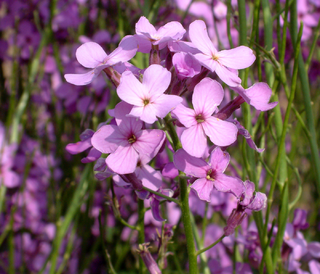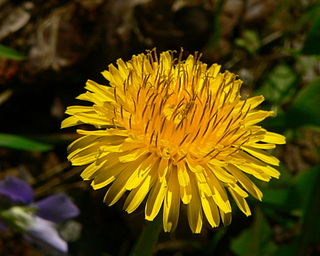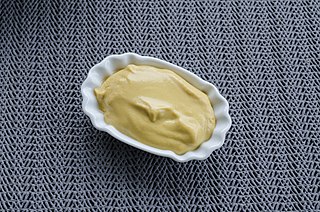
Flax, also known as common flax or linseed, is a flowering plant, Linum usitatissimum, in the family Linaceae. It is cultivated as a food and fiber crop in regions of the world with temperate climates. Textiles made from flax are known in Western countries as linen and are traditionally used for bed sheets, underclothes, and table linen. Its oil is known as linseed oil. In addition to referring to the plant, the word "flax" may refer to the unspun fibers of the flax plant. The plant species is known only as a cultivated plant and appears to have been domesticated just once from the wild species Linum bienne, called pale flax. The plants called "flax" in New Zealand are, by contrast, members of the genus Phormium.

The turnip or white turnip is a root vegetable commonly grown in temperate climates worldwide for its white, fleshy taproot. The word turnip is a compound of turn as in turned/rounded on a lathe and neep, derived from Latin napus, the word for the plant. Small, tender varieties are grown for human consumption, while larger varieties are grown as feed for livestock. In Northern England, Scotland, Ireland, Cornwall and parts of Canada, the word turnip often refers to rutabaga, also known as swede, a larger, yellow root vegetable in the same genus (Brassica).

The radish is an edible root vegetable of the family Brassicaceae that was domesticated in Asia prior to Roman times.

Caraway, also known as meridian fennel and Persian cumin, is a biennial plant in the family Apiaceae, native to western Asia, Europe, and North Africa.

Centaurea cyanus, commonly known as cornflower or bachelor's button, is an annual flowering plant in the family Asteraceae native to Europe. In the past, it often grew as a weed in cornfields, hence its name. It is now endangered in its native habitat by agricultural intensification, particularly by over-use of herbicides. However, Centaurea cyanus is now also naturalised in many other parts of the world, including North America and parts of Australia through introduction as an ornamental plant in gardens and as a seed contaminant in crop seeds.

Hesperis matronalis is an herbaceous plant species in the family Brassicaceae. It has numerous common names, including dame's rocket, damask-violet, dame's-violet, dames-wort, dame's gilliflower, night-scented gilliflower, queen's gilliflower, rogue's gilliflower, summer lilac, sweet rocket, mother-of-the-evening, Good & Plenties, and winter gilliflower.

Myrrhis odorata, with common names cicely, sweet cicely, myrrh, garden myrrh, and sweet chervil, is a herbaceous perennial plant belonging to the celery family Apiaceae. It is the only species in the genus Myrrhis.
White Americans are Americans who identify as white people. This group constitutes the majority of the people in the United States. According to the 2020 census, 71%, or 235,411,507 people, were white, and 61.6%, or 204,277,273 people, were white alone. This represented a national white demographic decline from a 72.4% white alone share of the U.S. population in 2010.

White mustard is an annual plant of the family Brassicaceae. It is sometimes also referred to as Brassica alba or B. hirta. Grown for its seeds, used to make the condiment mustard, as fodder crop, or as a green manure, it is now widespread worldwide, although it probably originated in the Mediterranean region.

Sinapis arvensis, the charlock mustard, field mustard, wild mustard, or charlock, is an annual or winter annual plant of the genus Sinapis in the family Brassicaceae. It is found in the fields of North Africa, Asia and Europe. Pieris rapae, the small white butterfly, and Pieris napi, the green veined white butterfly are significant consumers of charlock during their larval stages.
The 1987 Masters was a professional non-ranking snooker tournament that took place between 25 January and 1 February 1987 at the Wembley Conference Centre in London, England.

Taraxacum is a large genus of flowering plants in the family Asteraceae, which consists of species commonly known as dandelions. The scientific and hobby study of the genus is known as taraxacology. The genus is native to Eurasia and North America, but the two most commonplace species worldwide, T. officinale and T. erythrospermum, were introduced from Europe into North America, where they now propagate as wildflowers. Both species are edible in their entirety. The common name dandelion is also given to specific members of the genus.
Daniel Mullane is an Irish celebrity chef, television personality and proprietor of the restaurant, The Mustard Seed in Ballingarry, County Limerick. Himself and his cookery have featured on the RTÉ One television series Guerrilla Gourmet. He has received numerous awards, including Black & White Awards. His cookery has received positive reviews in publications such as the Irish Independent.

Mustard is a condiment made from the seeds of a mustard plant.
Bloomer is a potato variety. Bloomers produce round purplish-blue tubers with fairly deep eyes. The flesh is cream coloured.
Mizen is a high-yielding creamy yellow skinned potato that produces long, smooth-skinned tubers with good resistance to foliar and tuber blight. Flesh is white with medium dry-matter content. Mizen is one of the potato varieties bred in the 1970s at Teagasc Oak Park breeding centre in County Carlow, Ireland.
The Ulster Emblem variety of potato originated in Northern Ireland. It was originally bred by Mr J. Clarke of Ballymoney, Co. Antrim. It has a long oval shape with white skin and flesh which has a semiwaxy texture, reasonable flavour with good cooking quality, and a fairly good yield. This variety has a red violet coloured flower and a pink sprout colour. It also has a high resistance to late blight on the tubers as well as the plant foliage.
Champion is a potato variety bred by John Nicoll in Scotland and widely grown in Ireland during the latter half of the 19th century. The tuber is round, with white skin and yellow flesh. The texture is described as "floury".
The 2022 Northern Ireland Open was a professional snooker tournament that took place from 16 to 23 October 2022 at the Waterfront Hall in Belfast, Northern Ireland. Organised by the World Snooker Tour, it was the fourth ranking event of the 2022–23 season, the first tournament in the Home Nations Series, and the third tournament in the BetVictor Series. It was the seventh edition of the Northern Ireland Open since the event was first staged in 2016. The tournament was broadcast on Quest and Eurosport domestically. The winner received £80,000 from a total prize purse of £427,000.












